

Table of contents
- Hardy perpetual bloomers
- From B to F
- From G to K
- From O to R
- with S
- frequently asked Questions
Hardy perennials as permanent bloomers in the flower bed enchant the garden from early summer to autumn with a colorful bloom. They are easy to care for and magically attract butterflies, bees and the like.
Hardy perpetual bloomers
As perpetual bloomers are different types of flowers referred to, which produce a rich flower splendor continuously and permanently over a period of at least three months. The flowering period must take place in two consecutive seasons. Such flowering wonders can be robust perennials, but also annuals or biennial flowers be. Below is a small list of the most beautiful hardy perennials and perennials:
From B to F
Penstemon (Penstemon)
The magnificent cut flower is very bee friendly. The perennial originally comes from North America and Mexico.

- Growth: 40 to 100 cm, upright, bushy to slightly herbaceous
- Flowering period: July to September
- Flowers: Bell-shaped single flowers in panicles; white, pink, violet, red
- Location: sun
- Soil: permeable, fresh, rich in humus and nutrients
Blue catnip (Nepeta x faassenii)
This bee-friendly bedding perennial feels right next to evening primrose, yarrow and junker lily well.
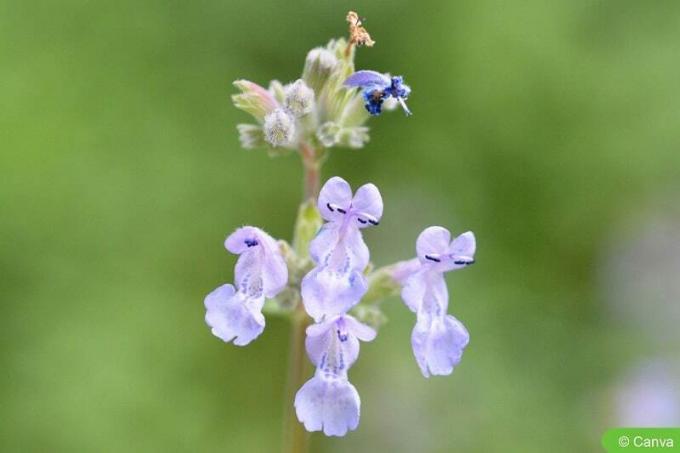
- Growth: 20 to 60 cm, upright, bushy, clump-forming
- Flowering period: May to September
- Flowers: Labiate flowers in spikes, fragrant; blue, violet
- Location: sun
- Soil: dry to fresh, well-drained, gritty-loamy, moderately nutritious
Bush mallow (Lavatera)
This hardy perennial lives up to the name permanent bloomer. However, it usually only flowers for two to three years.
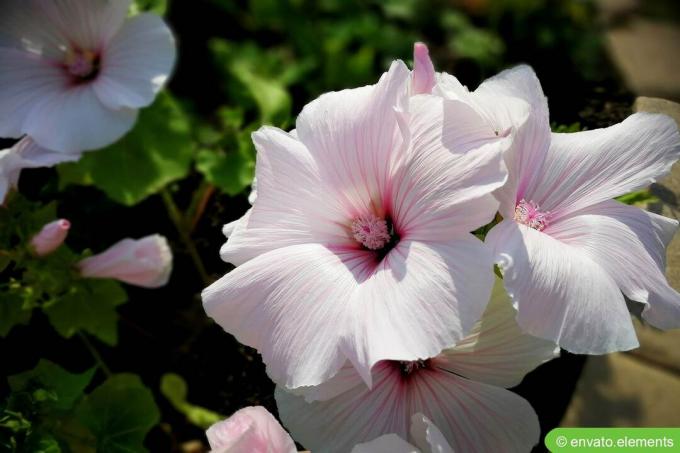
- Growth: 100 to 400 cm, upright, bushy
- Flowering period: July to October
- flowers: terminal cup-shaped flowers, standing in racemes; pink, white
- Location: sun to semi-shade
- Soil: fresh to slightly moist, sandy to loamy, tolerant of lime, rich in nutrients and humus
Bertram's sheaf (Achillea ptarmica)
The wild perennial originally comes from Eurasia. The marsh yarrow makes a good cut flower and is suitable for everyone perennial bed.

- Growth: 30 to 100 cm, upright, clump-forming
- Flowering period: July to October
- flowers: cymes, white
- Location: sun to semi-shade
- Soil: slightly moist, gravelly to clayey, calcareous, moderately nutritious
Tip:
Pruning after flowering will encourage reblooming.
Sweet nettle (Agastache)
The smell of aniseed and fennel when the leaves are crushed is typical of this plant.
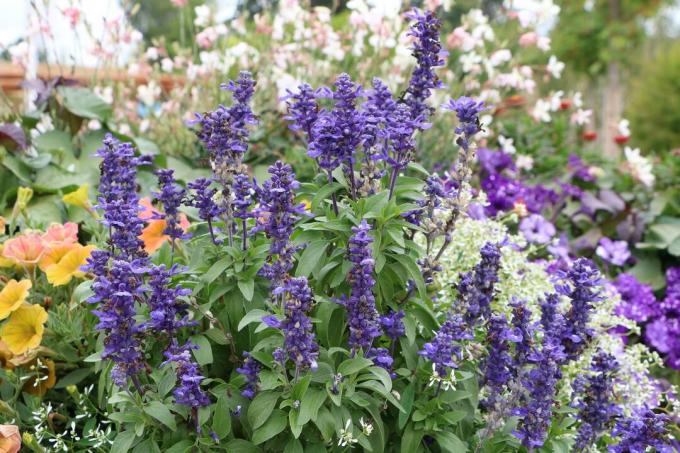
- Growth: 30 to 250 cm, bushy, upright, clump-forming
- Flowering period: June to September
- flowers: dense false spikes; white, blue, pink, red, orange
- Location: sun
- Soil: permeable, dry, calcareous, loamy-sandy
flame flower (phlox)
This fragrant cut flower is the classic among cottage garden plants. The strength of the fragrance depends on the temperature, it is particularly strong at noon or in the evening.
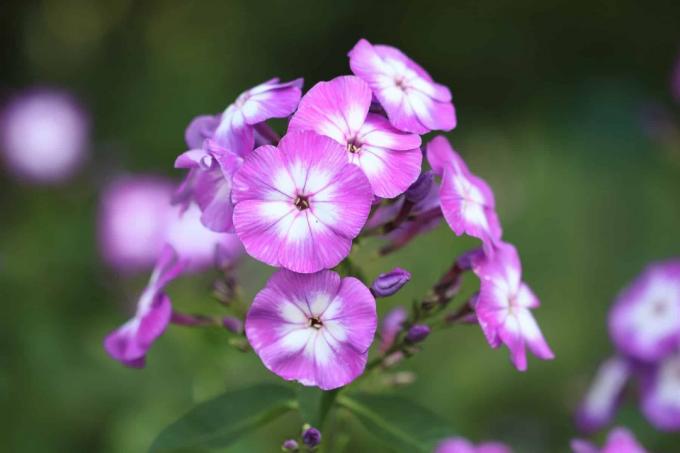
- Growth: 100 to 120 cm, clumpy, bushy, upright
- Flowering period: July to September
- flowers: in panicles; white, pink, red, fuchsia, blue, violet
- Location: sun to semi-shade
- Soil: fresh to moist, permeable, rich in humus and nutrients
From G to K
Large-flowered garden marguerite (Leucanthemum x superbum)
Planted in larger groups of three to five, this radiant cut flower sets accents in every perennial border.
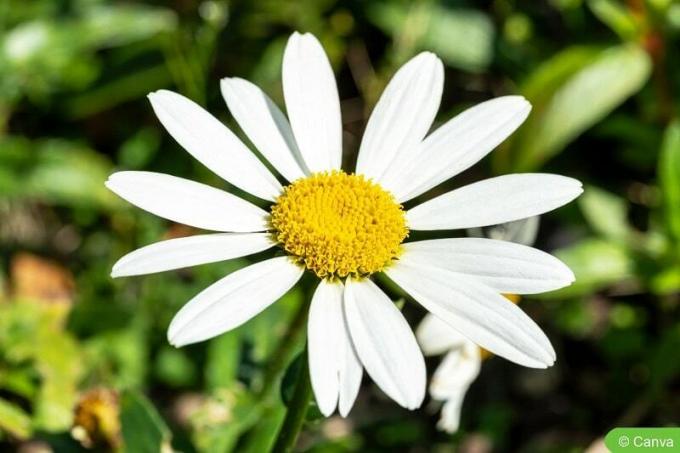
- Growth: 50 to 70 cm, loose clumps, upright
- Flowering period: May to September
- Flowers: terminal single flowers, large-flowered, radiating, white, light yellow
- Location: sun
- Soil: well-drained, fresh, loamy, rich in nutrients and humus
Large-flowered Tickseed (Coreopsis grandiflora)
The hardy perennial, which originates from the dry forests and prairies of North America, feels particularly at home as a permanent bloomer in near-natural steppe and prairie gardens in the vicinity of blue ones bluebells and violet delphinium.

- Growth: 40 to 80 cm, forms clumps, upright
- Flowering period: June to October
- Flowers: single flowers, composite flowers, yellow
- Location: sun
- Soil: moderately dry to moist, well-drained, sandy-loamy, rich in humus and nutrients
Great masterwort (Astrantia major)
The masterwort is a definite favorite for cottage gardens or natural gardens. She sets special accents in small groups with ornamental grasses.
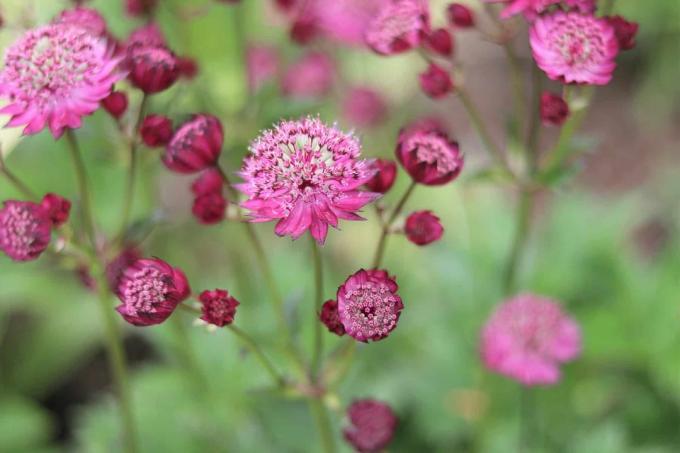
- Growth: 50 to 70 cm, upright, bushy, clump-forming
- Flowering period: June to August
- Flowers: terminal, single flowers in umbels, red, white, pink
- Location: shady to semi-shady
- Soil: fresh to moderately moist, calcareous, well-drained, sunny-loamy, rich in nutrients and humus
Iceland poppy (Papaver nudicaule)
This lovely perennial, with its flowers glowing from afar, is native to the subarctic regions of Iceland, the USA and Canada.
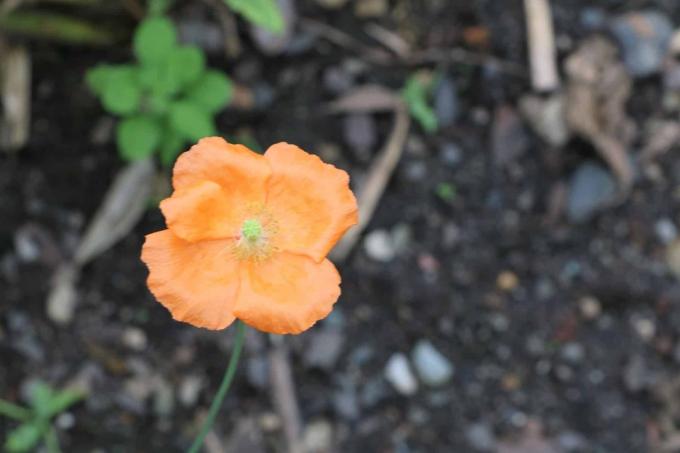
- Growth: 30 to 50 cm, upright, clump-forming
- Flowering period: May to August
- Flowers: single, terminal cupped flowers, light yellow, white, orange-colored, red
- Location: sunny to slightly shaded
- Soil: dry to fresh, rocky to sandy-loamy, well-drained, poor in humus and nutrients
A notice:
All parts of the plant contain a poisonous milky sap.
Blanket Flower (Gaillardia)
Originally from the dry steppes and grasslands of North and South America, this flower will add a splash of color to any garden.

- Growth: 15 to 75 cm, bushy, upright
- Flowering period: July to October
- Flowers: terminal, plate-shaped individual flowers, yellow, orange, red, multicolored
- Location: sun
- Soil: moderately dry to fresh, gravelly to sandy, likes lime, rich in nutrients and humus
Tip:
In autumn, the plants should be cut back to just above the ground in order to promote the willingness to flower the following year.
Globe thistle (Echinops ritro)
After flowering, beautiful seed pods develop from the spherical flowers, which are suitable for drying.
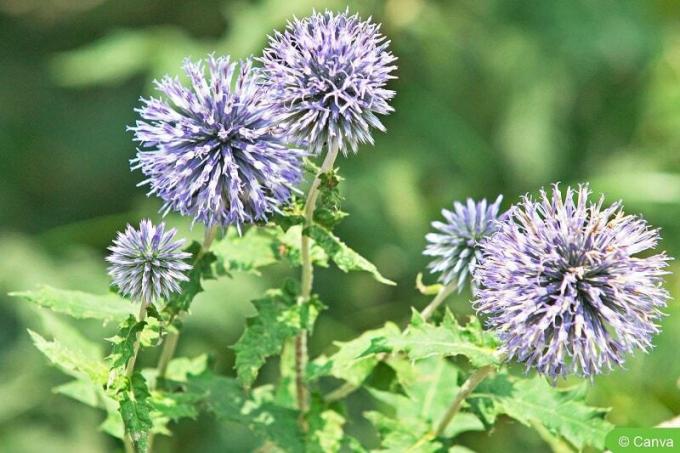
- Growth: 60 to 100 cm, basal tuft of leaves, upright, clumpy
- Flowering period: July to October
- flowers: ball-shaped, light blue, blue to violet-blue
- Location: sun
- Soil: dry to slightly moist, well-drained, gritty-loamy, rich in humus, moderately nutritious
From O to R
Ox tongue (Anchusa officinalis)
This wild perennial is particularly suitable for planting in natural gardens, in perennial beds, at the edge of trees and gravel beds.
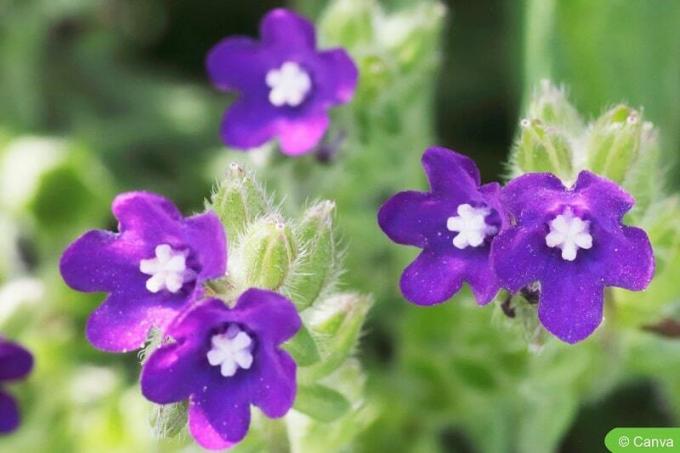
- Growth: 40 to 130 cm, upright, clumpy
- Flowering period: June to September
- Flowers: cup-shaped single flowers, violet, red
- Location: sun
- Soil: dry to slightly moist, well-drained, nutritious, sandy-loamy
Magnificent Candle (Gaura lindheimeri)
The individual flowers of this easy-care perpetual bloomer only open for one day. The perennial is a good companion for roses.

- Growth: 80 to 150 cm, forms clumps, bushy, upright
- Flowering period: June to October
- Flowers: simple cup-shaped flowers, hanging in loose racemes, white, pink
- Location: sunny, sheltered from the wind
- Soil: permeable, dry, gravelly-sandy, poor in humus and nutrients
Purple Coneflower (Echinacea purpurea)
This popular garden perennial is also known as red mock coneflower or hedgehog's head and is native to the prairies of North America.

- Growth: 80 to 100 cm, upright, bushy, clump-forming
- Flowering period: July to September
- Flowers: double, single, flower heads, slightly fragrant
- Flower color: yellow, orange, red, white
- Location: Sun to light semi-shade
- Soil: moderately dry to moist, gravelly to sandy, rich in humus and nutrients
Larkspur (Delphinium)
Characteristic of this perennial bloomer is the backward-pointing spur on the back of each flower of the hardy perennial.
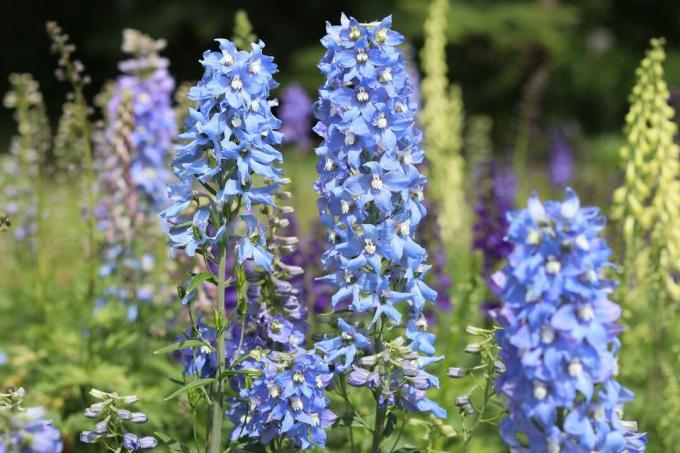
- Growth: 120 to 180 cm, clumpy, upright
- Flowering period: June to September
- flowers: double, single, in racemes
- Flower color: light blue, blue-violet, white, pink, yellow
- Location: sun
- Soil: well-drained, fresh to slightly moist, sandy-loamy, nutritious
with S
Yarrow (Achillea)
This native perennial makes excellent bee pasture and is ideal for semi-natural gardens.

- Growth: 40 to 60 cm, upright, bushy, clump-forming
- Flowering period: June to October
- flowers: flat cymes
- Flower color: yellow, white, red
- Location: sun
- Soil: well-drained, fresh to moist, rich in humus and nutrients, loamy-sandy
Scabiosis (Scabiosa)
This long lasting cut flower magically attracts butterflies and bees.

- Growth: 60 to 80 cm, upright, clump-forming
- Flowering period: June to October
- flowers: terminal single flowers, plate-shaped
- Flower color: violet, blue, white, red
- Location: sun
- Soil: permeable, fresh, rich in humus and nutrients, sandy-loamy
Suneye (Heliopsis)
This undemanding perennial is particularly good in combination with semi-tall plants grasses, phlox and asters.
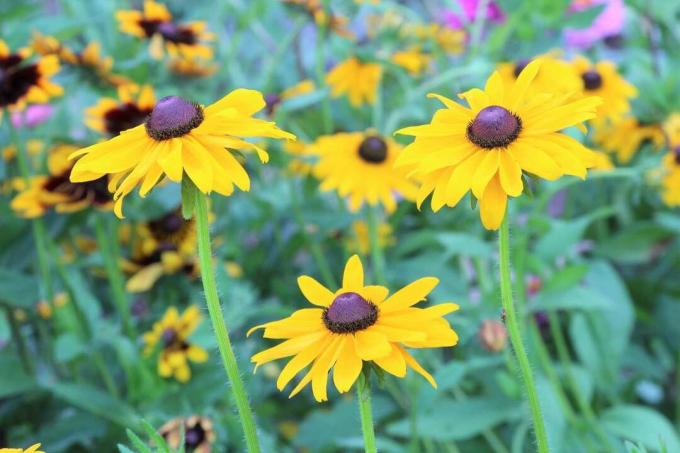
- Growth: 60 to 170 cm, upright, bushy, clump-forming
- Flowering period: July to October
- flowers: dense single flower heads
- Flower color: yellow, orange
- Location: sun to semi-shade
- Soil: dry to fresh, calcareous, nutritious, loamy-sandy
Sunbride (Helenium)
This distinctive summer flower is the ideal companion for roses and ornamental grasses.
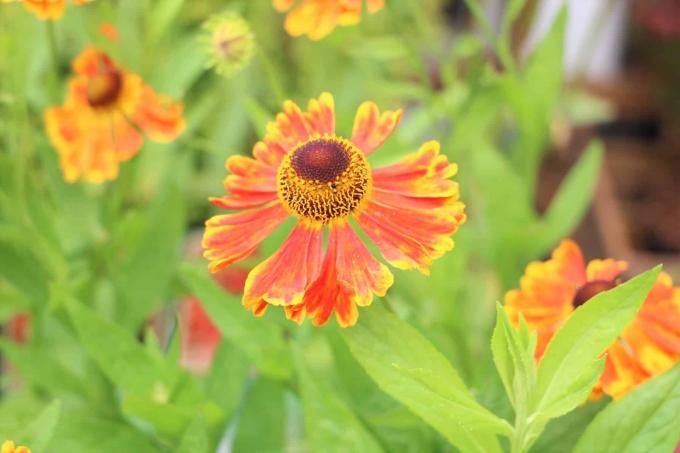
- Growth: 100 to 120 cm, upright, clumpy
- Flowering period: June to October
- Flowers: daisy umbels
- Flower color: yellow, red, orange, reddish brown
- Location: sun
- Soil: well-drained, fresh, loamy-sandy, rich in humus and nutrients
Hollyhock (Alcea rosea)
This hardy perennial is perfect for nostalgic gardens as a permanent bloomer alongside smaller colored perennials.
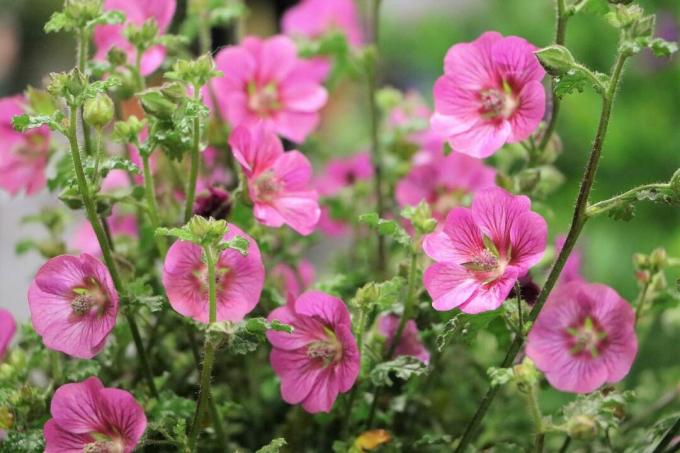
- Growth: 180 to 250 cm, upright, forming clumps
- Flowering period: June to September
- flowers: double, single, bowl-shaped single flowers
- Flower color: red, orange, violet, yellow, pink, white
- Location: sunny to off-sun
- Soil: dry to moderately moist, well-drained, gritty-loamy, rich in humus and nutrients
Spurflower (Centranthus)
This easy care and adaptable hardy perennial is the perfect companion for lady's mantle, cranesbill and lavender.

- Growth: 60 to 80 cm high, clumpy, upright
- Flowering time: April to October
- Flowers: small cymes, in panicles
- Flower color: white, red
- Location: sun
- Soil: dry to fresh, calcareous, stony-sandy, low in humus and nutrients, pH 6.0 to 8.0
frequently asked Questions
All faded flowers should be plucked or cut off regularly. This stimulates the formation of new flowers. It is also advisable to cut off faded perennials close to the ground as soon as possible. This is followed by fertilization and regular watering. After a few weeks it will sprout again with flowering.
Normally, winter protection is not absolutely necessary, as they pull in their above-ground shoots in the fall. The overwintering buds are usually sheltered in the ground. However, perennial perennials should also receive winter protection from a layer of leaves or fir branches, especially in harsh areas. This provides protection against temperature fluctuations that occur and at the same time frost damage is avoided if the buds sprout early.
 Mirko
Mirko
Learn more about perennials

20 hardy plants that bloom all year round
With plants that bloom all year round, you can quickly create an attractive garden that does not require much maintenance, as long as the plants are also hardy. In this post, we will introduce you to 20 plants that are suitable for this.

17 flowering hardy plants May to October
Many plants only show their full splendor for a short time. But there are also types and varieties with a particularly long flowering period from May to October, sometimes even longer. We present 17 flowering hardy plants.

10 care tips for the banana tree
If you like it exotic, cultivate a banana tree as a houseplant or in the conservatory. In summer, the banana plants are even allowed outside for a few weeks. The large leaves that the Musa forms on a false trunk are particularly decorative and impressive, and therefore look like a small tree.

Properly care for globe thistle | 10 tips for care
The globe thistle is an eye-catcher in the garden. Their spherical flowers provide a food source for insects. The globe thistle is not difficult to care for and it is suitable for dry locations. With a few tips on care, the plants will develop even better.
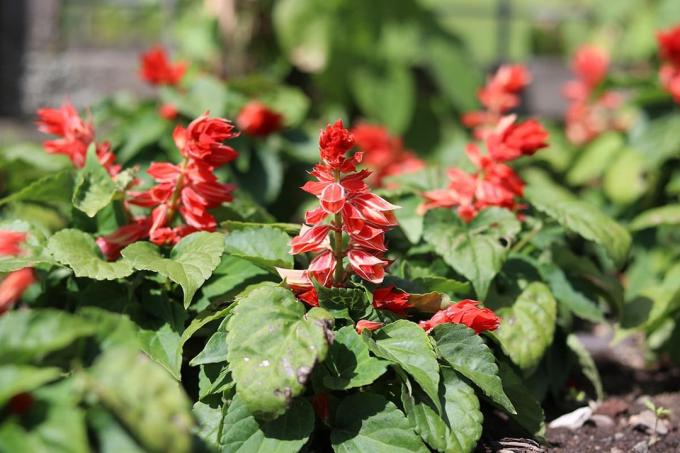
Fire sage, Salvia splendens: care from A to Z
Fire sage is known in botanical jargon as Salvia splendens and is a particularly decorative eye-catcher. But what kind of care does the plant need? Our guide to the salvia shows the important points from A to Z.
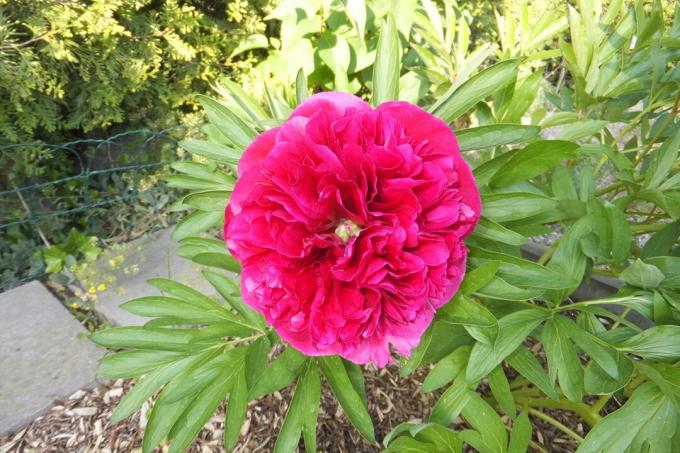
Peonies, Paeonia: 11 tips for care
Peonies enchant with their extremely decorative flowers, which draw everyone's attention. In order for the flowers to be particularly lush and to last for a long time, care must be taken accordingly. Our tips show how the Paeonia thrives best.



